|
|
 |
|
Calanoida ( Order ) |
|
|
|
Clausocalanoidea ( Superfamily ) |
|
|
|
Aetideidae ( Family ) |
|
|
|
Aetideopsis ( Genus ) |
|
|
| |
Aetideopsis minor (Wolfenden, 1911) (F) | |
| | | | | | | Syn.: | Faroella minor Wolfenden, 1911 (p.214, Descr.F);
Chiridius minor : Farran, 1929 (p.208, 230, Rem.);
Chiridius modestus With, 1915 (p.82, figs.F);
Aetideopsis multiserrata : Brodsky, 1950 (1967) (p.148, figs.F); Markhaseva, 1984 (p.512) | | | | Ref.: | | | Vervoort, 1951 (p.72, figs.F, Rem.); 1957 (p.6, 52, Rem.); Tanaka & Omori, 1970 (p.112, 114, Rem.); Bradford, 1971 b (p.18, fig.F); Park, 1978 (p.115, figs.F); Bradford & Jillett, 1980 (p.19, figs.F, fig. 73, distribution chart); Björnberg & al., 1981 (p.605, 630, fig.F); Razouls, 1994 (p.69, figs.F, Rem.); Markhaseva, 1996 (p.32, figs.F); Bradford-Grieve & al., 1999 (p.879, 920, figs.F) |  issued from : T. Park in Antarctic Res. Ser. Washington, 1978, 27. [p.116, Fig.8]. Female: A, habitus (dorsal view); B, idem (left lateral view); C, posterior part of prosome and urosome (dorsal view); D, idem (left lateral view); E, forehead (lateral); F, rostrum (anterior).
|
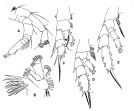 issued from : T. Park in Antarctic Res. Ser. Washington, 1978, 27. [p.117, Fig.9]. Female: A, A2; B, Mx1; C, P1 (anterior view); D, P2 (idem); E, P4 (idem).
|
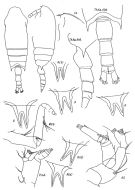 issued from : E.L. Markhaseva in Trudy Zool. Inst. RAN, St. Petersburg, 1996, 268. [p.35, Fig.20]. Female. From different specimens. Ce: forehead (lateral); R: rostrum (anterior); P;md: mandibular palp; (a): sub-Antarct.: SW Atlant. sector: 56°25'S, 36°57'W; (b): Arctic Basin: 83°33'N, 142°39'E; other figures: 74°30'N, 4°18'E.
|
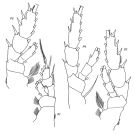 issued from : E.L. Markhaseva in Trudy Zool. Inst. RAN, St. Petersburg, 1996, 268. [p.36, Fig.21]. Female (from 74°30'N, 4°18'E).
|
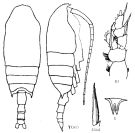 Issued from : K.A. Brodskii in Calanoida of the Far Eastern Seas and Polar Basin of the USSR. Opred. Fauna SSSR, 1950, 35 (Israel Program for Scientific Translations, Jerusalem, 1967) [p.148, Fig.62]. As Aetideopsis multiserrata. Female (from Arctic): habitus (dorsal and lateral right side): R, rostrum; S1, P1; S3AS, apical spine of P3. Nota: Serratures of apical spines of exopodites of swimming legs very dense, sharp, without intervals.
|
 issued from : W. Vervoort in Verh. K. ned. Akad. Wet., Afd. Natuurk., 1951, (Sect. 2) 47 (2). [p.73, Fig.40]. Female (from 66°58'S, 16°03'W): a, habitus (lateral); b, posterior part cephalothorax and urosome (lateral); c, left Md (mandibular palp); d, rostrum (ventral aspect). Nota : Forehead dorsally broadly triangular. Rostrum highly chitinized, it consists of 2 acutely pointedfrontal organ not visible dorsally. Head and 1st thoracic segment fused, 4th and 5th separate (the indication of a line of fusion is visible in lateral aspect on the back). Proportional lengths of cephalothorax and abdomen as 16 :5. Body with a thick, well chitinized carapace with, on the thorax, a characteristic pitted structure. Postero-lateral margin of 5th thoracic segment produced in a fla-like prolongation, covering 1/3 of the genital segment ; in dorsal saspect these prolongations more or less have the character of spines with swollen basal portion ; laterally they are narrowly triangular. Abdomen 4-segmented ; proportional lengths with the caudal rami 37 :19 :15 :11 :18 = 100.
|
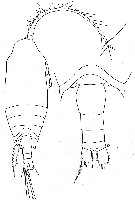 issued from : W. Vervoort in Verh. K. ned. Akad. Wet., Afd. Natuurk., 1951, (Sect. 2) 47 (2). [p.75, Fig.41]. Female: a, habitus (dorsal); b, posterior part cephalothorax and urosome (dorsal). Nota: Génital somite symmetrical ; genital flap not seen and no trace of receptacles. The 1st-3rd abdominal segments with finely serrated lamellae along their distal border. Anal segment small, with a distinct anal operculum. Caudal rami 1.5 times as long as wide and parallel ; each ramus with 4 marginal plumose setae, plus 1 external seta, short, fine and plumose ; internal margin of rami with fine, long hairs.
|
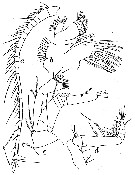 issued from : W. Vervoort in Verh. K. ned. Akad. Wet., Afd. Natuurk., 1951, (Sect. 2) 47 (2). [p.76, Fig.42]. Female: a, left A1; b, left Mx1; c, left A2; d, right Mxp. Nota: A1 24-segmented (8th-9th segments fused, 24th and 25th only weakly indicated), directed forwards, length exceeding the cephalothorax. Endopod of A2 shorter than the exopod ; the apex of the endopod reaches the middle of the last exopodal segment. Mx1 with 1st lobe carrying 10 strong, plumose or denticulate spines and 4 small setae on the posterior surface ; 2nd and 3rd inner lobes elongate, each with 4 strong setae ; 1st outer lobe with 9 setae, 6 of which are strong and 3 are small ; 2nd outer lobe distinctly visible, without seta ; exopod small, with 11 small, plumose setae ; 2nd basal segment well separated from the endopod, with 5 setae ; endopodal segments well separated, the 1st with 4 setae, the 2nd with 3, the 3rd with 6 setae.
|
 issued from : W. Vervoort in Verh. K. ned. Akad. Wet., Afd. Natuurk., 1951, (Sect. 2) 47 (2). [p.77, Fig.43]. Female: a, left Mx2; b, left Md (cutting edge).
|
 issued from : W. Vervoort in Verh. K. ned. Akad. Wet., Afd. Natuurk., 1951, (Sect. 2) 47 (2). [p.79, Fig.44]. Female: right P1; b, right P2; c, left P4; d, right P3. (all feet the anterior surface).
|
 Aetideopsis minor Aetideopsis minor female: 1 - Endopod of P1 with external lobe. 2 - Posterior corners of last thoracic segment not wing-like, not divergent (dorsal view). Genital segment (dorsal view) barrel-like without lateral swellings. 3 - Crest faintly developed begining at the level of A2. 1st and 2nd external spines of exopodal segments 1 and 2 of P1 exceeding base of next spine. 4 - Endopod of P2 2-segmented (though separation between segments may be incomplete). Points of last thoracic segment reaching the midlength of genital segment. 5 - Anterior part of cephalon (lateral view) fairly smoothly transforming into rostrum, not prominent over base of rostrum. 6 - Rostrum well developed, rami not close-spaced, more or less divergent. 7 - Mxp protopodite withot projection in proximal part.
|
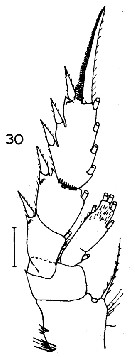 Issued from : J.M. Bradford in N.Z. Oceanogr. Inst., 1971, 206, Part 8, No 59. [p.17, Fig.30]. Female (from 75°09'S, 171°00'W): 30, P2 Scale bar: 100 µm. Nota : Endopods of P2-P4 with very fine spinules on their anterior surface, distally. Exopods of P2-P4 with one anterior surface glandular pore on each segment at the base of the terminal lateral spine. The pores on P3-P4 tend to open directly laterally. 2nd exopodal segment of P1 with a patch of spines on the anterior surface. The surface of the metasome is not pitted as stated by Vervoort (1951) but covered with raised chitinous lumps or pickles as in A. antarctica although not as long. They are present on the urosome also but are so small as to be almost indistinguishable.
|
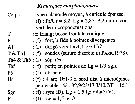 Issued from : C. Razouls in Ann. Inst. océanogr., Paris, 1994, 70 (1). [p.69]. Caractéristiques morphologiques de Aetideopsis minor femelle et mâle adultes. Terminologie et abbréviations: voir à Calanus propinquus. Nota: Mâle inconnu. Peut être confondu avec Aetideopsis antarctica qui présente également un corps granuleux, mais de taille plus grande, un rostre présentant une encoche plus large et des pointes parallèles, des ponctuations sur l'urosome bien visibles. Deux individus femelles ont été observés à la Station Kerfix (Kerguelen): Specimen 1- Lg totale 3,04 mm; rapport Pr/Ur = 3,1; Sgn Lg/lg = 1; A1 atteint presque les rames caudales; le segment thoracique 5 est visible mais très étroit, les pointes postérieures atteignent environ la moitié du segment génital ; les pointes rostrales sont moins divergentes que dans Bradford & Jillett (1980, p.19, fig. 9B) et dans Park (1978, p.116, fig. 8F); les micro-ponctuations nr sont pas visibles sur l'urosome. Specimen 2 ^Lg totale 3,02 mm; Pr/ur = 3,13; A1 dirigée vers l'avant, la longueur (repliée vers l'arrière) atteint plus ou moins le segment génital; la suture du Th5 est peu visible; pointes postérieures de th5 atteignent la moitié du segment génital; Sgn: Lg/lg ± 1; le front (en vue latérale) en bosse, les pointes rostrales comme pour le specimen précédent; microponctuations invisibles sur l'urosome.
| | | | | Compl. Ref.: | | | Hopkins, 1985 (p.197, Table 1, gut contents); Hopkins & Torres, 1988 (tab.1); Ward, 1989 (tab.2); Fransz & Gonzalez, 1997 (p.395, weight-length, biomass v.s. N-S transect); Kosobokova al., 1998 (tab.2); Auel, 1999 (tab.2); Razouls & al., 2000 (p.343, tab. 4, 5, Appendix); Kosobokova & Hirche, 2000 (p.2029, tab.2); Schulz & Markhaseva, 2000 (p.77); Auel & Hagen, 2002 (p.1013, tab.2); Bradford-Grieve, 2004 (p.283); Kosobokova & al., 2007 (p.919, Tab.3, 6, 7, fig.2); Blachowiak-Samolyk & al., 2007 (p.2716, Table 2); Blachowiak-Samolyk & al., 2008 (p.2210, Table 3, biomass); Schnack-Schiel & al., 2008 (p.1045: Tab.2); Laakmann & al., 2009 (p.741, fig.2, vertical distribution, lipids analysis); Laakmann & al., 2009 (p.679, fig.2, 4, Table 2); Park & Ferrari, 2009 (p.143, Table 4, 6: bipolar distribution, Appendix 1, biogeograzphy); Kosobokova & Hopcroft, 2010 (p.96, Table 1, fig.7); Bucklin & al., 2010 (p.40, Table 1, Biol mol.); Kosobokova & al, 2011 (p.29, Table 2, figs.4, 8, Rem.: Arctic Basins); Laakmann & al., 2012 (p.535, Table 1, fig.2, Rem.: mol. Biol.); Michels & al., 2012 (p.369, Table 1, occurrence frequency); Kouwenberg & al., 2014 (p.290, biogeography, Map 10); Smoot & Hopcroft, 2016 (p.1, fig.7, vertical distribution) | | | | NZ: | 4 | | |
|
Distribution map of Aetideopsis minor by geographical zones
|
| | | | | | 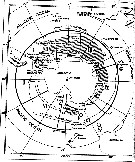 issued from : W. Vervoort in B.A.N.Z. Antarctic Reseach Expedition, Reports - Ser. B, Vol. III, 1957 [Fig.8]. issued from : W. Vervoort in B.A.N.Z. Antarctic Reseach Expedition, Reports - Ser. B, Vol. III, 1957 [Fig.8].
Chart showing the geographical distribution (white triangle) in the seas surrounding the Antarctic continent.
Nota: In this chart the area frequented by whaling vessels has been hatched. The Antarctic circle (66°.5 S) has been drawn as a broken line. The numbers I to VI refer to the sectors into which the Antarctic seas are divided according to Mackintosh (1942) (after Vervoort, 1951). |
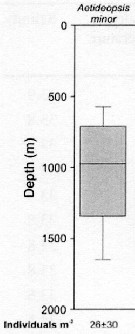 issued from : S. Laakmann, M. Stumpp & H. Auel in Polar Biol., 2009, 32. [p.682, Fig.2]. issued from : S. Laakmann, M. Stumpp & H. Auel in Polar Biol., 2009, 32. [p.682, Fig.2].
Vertical distribution (stages C3 to C6 from Antarctic Polar Front: Atlantic sector).
Error bars encompass the 5th to the 95th percentile. Abundance data are given as mean ± SD.
Nota: The species was mainly distributed between 715 and 1,350 m with a low total abundance. Copepodids C3 and C4 showed a slightly shallower distribution than copepodids C5 and females. This species overlapped in distribution with both Gaetanus species (G. brevispinus and G. tenuispinus). |
 Issued from : S. Laakmann, M. Kochzius & H. Auel in Deep-Sea Res. I, 2009, 56. [p.745, Fig.2 c]. Issued from : S. Laakmann, M. Kochzius & H. Auel in Deep-Sea Res. I, 2009, 56. [p.745, Fig.2 c].
Vertical distribution abundance of copepodite stages C3 to C6 of Aetideopsis spp. and Chiridius obtusifrons. +: No occurrence; solid line depicts bottom profile (right axis); station 853 over the Yermak Plateau (81°22'N, 6°52'E) is separated from the other stations on the transect; other stations between East Greenland Current, the Fram Strait and the West Spitsbergen Current, into south return Atlantic Current (77°46'N-79°36'N, 6°20'E-7°29'W).
Deep-sea copepods collected from August 20 to September 16, 2006. |
 Issued from : J.H.M. Kouwenberg, C. Razouls & N. Desreumaux in Biogeographic Atlas of the Southern Ocean, Scient. Comm. Antarct. Res., Cambridge, 2014, 6.6. [p.293, Map 10]. Issued from : J.H.M. Kouwenberg, C. Razouls & N. Desreumaux in Biogeographic Atlas of the Southern Ocean, Scient. Comm. Antarct. Res., Cambridge, 2014, 6.6. [p.293, Map 10].
Distribution of Aetideopsis minor. |
| | | | Loc: | | | Antarct. (Croker Passage, Peninsula, Weddell Sea, SW & SE Atlant., Indian, SW & SE Pacif., Ross Sea), sub-Antarct. (Indian), Brazil-Argentina, Greenland Sea, Fram Strait, Spitsbergen, Norway Sea, Arct. (all basins, Canada Basin), Laptev Sea.
Type locality: South of 60°S- region of 85°W. | | | | N: | 32 | | | | Lg.: | | | (7) F: 3,69; (10) F: 2,56; (20) F: 3,2-2,92; (22) F: 3,5-2,8; (31) F: 3,2-2,95; (25) F: 3,25-2,82; (35) F: 3,25-2,92; (37) F: 3,9-2,87; (102) F: 2,9; (201) F: 3,25-2,87; (202) F: 3,15; (1001) F: 3,2 ±0,13; {F: 2,56-3,90} | | | | Rem.: | epi to bathypelagic depending on latitude.
Sampling depth (Antarct., sub-Antact.): 0-200-1000 m.
Example of a bipolar species.
For Vervoort (1951, p.80) this species is closely related to A. rostrata Sars, and A. multiserrata (Wolfenden).
After Markhaseva (1996, p.37) A. multiserrata was recorded in the Arctic Ocean (Brodsky, 1950; Minoda, 1967; Vidal, 1971; Markhaseva, 1984), but according to the figures (Brodsky, 1950; Vidal, 1971) and the examined original material from the Arctic Ocean, it is A. minor and not A. multiserrata
See remarks in A. antarctica. | | | Last update : 26/01/2017 | |
|
|
 Any use of this site for a publication will be mentioned with the following reference : Any use of this site for a publication will be mentioned with the following reference :
Razouls C., Desreumaux N., Kouwenberg J. and de Bovée F., 2005-2025. - Biodiversity of Marine Planktonic Copepods (morphology, geographical distribution and biological data). Sorbonne University, CNRS. Available at http://copepodes.obs-banyuls.fr/en [Accessed December 25, 2025] © copyright 2005-2025 Sorbonne University, CNRS
|
|
 |
 |



















